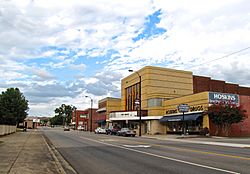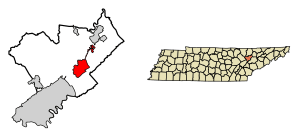Clinton, Tennessee facts for kids
Quick facts for kids
Clinton
|
|||
|---|---|---|---|

Main Street in Downtown Clinton
|
|||
|
|||

Location of Clinton in Anderson County, Tennessee.
|
|||
| Country | United States | ||
| State | Tennessee | ||
| County | Anderson | ||
| Incorporated | 1801 | ||
| Government | |||
| • Type | Council–manager | ||
| Area | |||
| • Total | 12.25 sq mi (31.72 km2) | ||
| • Land | 11.63 sq mi (30.11 km2) | ||
| • Water | 0.62 sq mi (1.60 km2) | ||
| Elevation | 824 ft (251 m) | ||
| Population
(2020)
|
|||
| • Total | 10,056 | ||
| • Density | 864.88/sq mi (333.93/km2) | ||
| Time zone | UTC-5 (Eastern EST) | ||
| • Summer (DST) | UTC-4 (EDT) | ||
| ZIP codes |
37716-37717
|
||
| Area code(s) | 865 | ||
| FIPS code | 47-15580 | ||
| GNIS feature ID | 1305981 | ||
Clinton is a city in Anderson County, Tennessee. It is the main city, or county seat, of the county. Clinton is also part of the larger Knoxville metropolitan area. In 2020, about 10,056 people lived there.
Contents
History of Clinton
Early Days
Long ago, Native American groups lived along the Clinch River. They were here during the Woodland period (1000 B.C. to 1000 A.D.) and the Mississippian period (1000 to 1550 A.D.). Scientists found old villages when building dams in the 1930s and 1950s.
Later, in the mid-1700s, European explorers and hunters came to the Clinch Valley. This land was claimed by the Cherokee people. A treaty in 1791 tried to stop new settlers. But more people kept moving into Tennessee from Virginia and North Carolina.
The first families to settle here included the Wallaces and Gibbs. After another treaty in 1798, more settlers arrived easily.
How Clinton Got Its Name
The town was started in 1801 and first called Burrville. It was named after Aaron Burr, who was the Vice President of the United States. Burrville became the county seat for the new Anderson County.
In 1809, the town's name was changed to Clinton. This happened because of a famous duel where Aaron Burr killed Alexander Hamilton. The new name likely honored George Clinton. He was a political rival of Burr and became Vice President after him.
World War II Connection
During World War II, a secret project called the Manhattan Project took place nearby. It was officially named the Clinton Engineer Works. This site produced special materials for the first atomic bombs. The largest part of this project was in Oak Ridge, just a few miles from Clinton.
Community and Development
In the 1990s, a company wanted to reopen a rock quarry and build an asphalt plant near Clinton. Many local people and environmental groups were against this. They worried about air quality, noise, and damage to the environment. The company said they would follow strict rules.
However, Anderson County did not allow the project at first. Later, in 2006, Clinton decided to include the quarry land into the city. In 2007, the city council voted to allow the industrial use. This led to a lawsuit from a group called Citizens for Safety and Clean Air.
Modern Changes
In 2018, plans began to improve downtown Clinton and its riverfront. This was after a new bridge was built over the Clinch River. A big part of this plan is the old Magnet Mills factory site. It has a long river view.
Ideas for this area include new shops and places to walk. There are also plans for buildings with homes and stores. In 2019, most of the old Magnet Mills buildings were taken down.
Also in 2019, a large park called Aspire was planned. It will be south of downtown Clinton. This park will have hiking and biking trails. It will also have places for kayaking and flower gardens. Construction on the park began in late 2019.
Geography of Clinton
Clinton is located along the Clinch River. The river here is part of Melton Hill Lake. This lake is a reservoir created by the Melton Hill Dam. Clinton is about 35 miles upstream from the dam.
The city is surrounded by long, narrow hills. These hills are part of the Appalachian Mountains. To the northwest is Walden Ridge, which is part of the Cumberland Plateau.
Major roads in Clinton include Tennessee State Route 61 and U.S. Route 25W. These roads connect Clinton to other towns and cities. Interstate 75 also passes near Clinton.
The United States Census Bureau says Clinton covers about 12.25 square miles. Most of this area is land, with a small part being water.
Climate
Clinton has a warm and humid climate. It gets rain throughout the year. This type of climate is called a Humid subtropical climate.
| Climate data for Clinton, Tennessee | |||||||||||||
|---|---|---|---|---|---|---|---|---|---|---|---|---|---|
| Month | Jan | Feb | Mar | Apr | May | Jun | Jul | Aug | Sep | Oct | Nov | Dec | Year |
| Mean daily maximum °C (°F) | 45 (7) |
50 (10) |
60 (16) |
70 (21) |
77 (25) |
84 (29) |
87 (31) |
86 (30) |
80 (27) |
70 (21) |
58 (14) |
48 (9) |
68 (20) |
| Mean daily minimum °C (°F) | 25 (−4) |
28 (−2) |
36 (2) |
43 (6) |
52 (11) |
60 (16) |
65 (18) |
64 (18) |
58 (14) |
45 (7) |
36 (2) |
29 (−2) |
45 (7) |
| Average precipitation mm (inches) | 5.1 (130) |
5.3 (130) |
5.7 (140) |
4.3 (110) |
3.8 (97) |
4.6 (120) |
5.2 (130) |
4.1 (100) |
3.2 (81) |
2.6 (66) |
3.6 (91) |
5 (130) |
52.7 (1,340) |
| Source: Weatherbase | |||||||||||||
People in Clinton
| Historical population | |||
|---|---|---|---|
| Census | Pop. | %± | |
| 1870 | 325 | — | |
| 1880 | 263 | −19.1% | |
| 1890 | 1,198 | 355.5% | |
| 1900 | 1,111 | −7.3% | |
| 1910 | 1,090 | −1.9% | |
| 1920 | 1,409 | 29.3% | |
| 1930 | 1,927 | 36.8% | |
| 1940 | 2,761 | 43.3% | |
| 1950 | 3,712 | 34.4% | |
| 1960 | 4,943 | 33.2% | |
| 1970 | 4,794 | −3.0% | |
| 1980 | 5,245 | 9.4% | |
| 1990 | 8,972 | 71.1% | |
| 2000 | 9,409 | 4.9% | |
| 2010 | 9,841 | 4.6% | |
| 2020 | 10,056 | 2.2% | |
The United States Census counts how many people live in a place. In 2020, there were 10,056 people living in Clinton. There were 4,417 households and 2,857 families.
2020 Census Information
| Race | Number | Percentage |
|---|---|---|
| White (not Hispanic) | 8,961 | 89.11% |
| Black or African American (not Hispanic) | 244 | 2.43% |
| Native American | 21 | 0.21% |
| Asian | 84 | 0.84% |
| Pacific Islander | 3 | 0.03% |
| Other/Mixed | 493 | 4.9% |
| Hispanic or Latino | 250 | 2.49% |
Famous People from Clinton
- Trey Hollingsworth, a congressman who was born in Clinton.
- John C. Houk, another congressman born in Clinton.
- The McKameys, a Southern Gospel music group based in Clinton.
- Charles McRae, a football player who was a first-round draft pick in the NFL.
- John R. Neal, a congressman born near Clinton.
- Paul Turner, a pastor known for helping to integrate Clinton High School.
- Larry Seivers, a two-time All-American football player at the University of Tennessee.
- Barry A. Vann, an author, speaker, and professor of historical geography.
Images for kids
See also
 In Spanish: Clinton (Tennessee) para niños
In Spanish: Clinton (Tennessee) para niños






